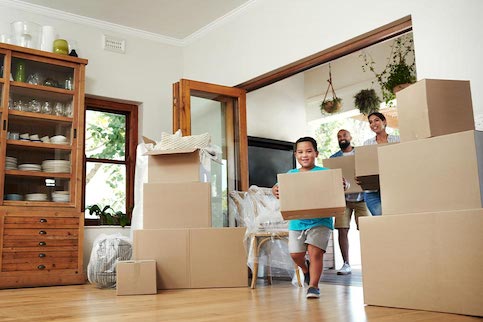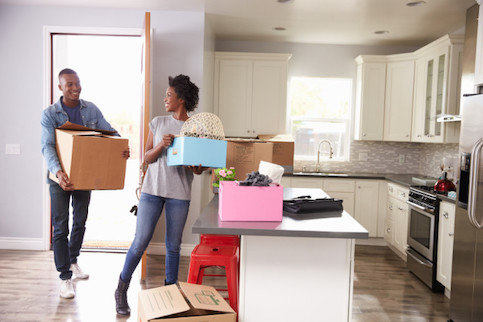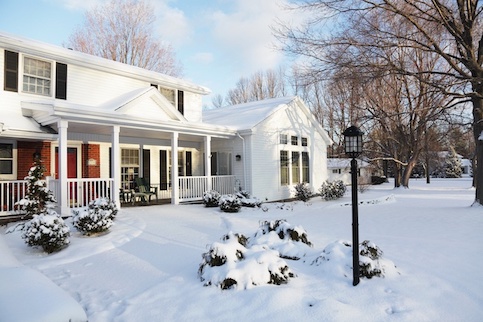There are two schools of thought around moving: It can be an exciting time for a change, or one of the most stressful experiences in existence. It could be some combination of the two. No matter how you feel about moving, leveraging a thoughtful plan and using the following strategic tips can help moving day – and the days before and after – run much smoother.
The Best Tip For Moving: Be Prepared
The most effective way to make the moving process more manageable and less stressful is to prepare as much as possible in advance (the advance part can’t be emphasized enough).
It’s possible for those facing a potential relocation to both strategically and methodically prepare their home. By using the moving hacks below, anyone can prepare their budget, organize their items, skillfully pack and limit the headaches associated with a major move. And the more time you give yourself to do these tasks, the less stress you’ll experience along the way.
Take the first step toward buying a house.
Get approved to see what you qualify for.
See What You Qualify For
Buy A Home
Discover mortgage options that fit your unique financial needs.

Refinance
Refinance your mortgage to have more money for what matters.
Tap Into Equity
Use your home’s equity and unlock cash to achieve your goals.
9 Top Moving And Packing Tips
1. Get Rid Of Unwanted Items
The best opportunity anyone has during a move is to downsize their belongings beforehand. Why? Because you’re already going through every single item during the packing process. Decluttering during a move also makes it easy to sort items by what you want to keep, donate or sell.
There are significant benefits to getting rid of unwanted items before the moving truck arrives: less to pack, less to physically move to a new location and less to find a place for once you arrive at your new house. Don’t limit yourself to only getting rid of smaller items. Moving is the perfect time to rehome or donate large furniture that may not fit well into your new space.
2. Keep All Moving Documents In One Place
Not every piece of paper in your filing cabinet will be needed during your move or even in the weeks afterward as you settle into your new home.
However, it’s crucial you keep all of the documents necessary for your move, such as address and utility information (or a laptop with this information) in one place and easily accessible on moving day. Don’t pack it away in a box. Rather, find a safe place for it in the kitchen by your purse or in the glove box of your car.
Taking this one step further, if you’ve hired a moving company, it is best practice to keep your sensitive documents (passports, Social Security cards, marriage certificates, etc.) and valuables in a safe place and move these items yourself. This way, you minimize the risk of your belongings getting lost in the move or compromised in transit, and you’re able to ensure these important, hard-to-replace items stay safe.
3. Start As Early As Possible
One of the silver linings of a move, particularly if you are moving after selling and buying a new home, is that you rarely have to move at a moment’s notice. Since the home buying process can take 60 – 90 days, this leaves ample time to get organized and prepare. Moving can be one of the most stressful experiences, but one of the primary ways to alleviate this stress is to start as early as possible and not wait until the last second.
Begin a few weeks out to give yourself ample time to go through your items, pare down what you do or don’t need, and then pack thoughtfully and carefully.
4. Find A Moving Truck With A Ramp
For individuals who are moving without professional assistance, there are several ways to make moving mentally and physically easier. Renting a moving truck, especially one with a ramp, will make loading and unloading easier and save time. Instead of taking multiple loads of furniture and belongings in cars or a pickup truck, a moving truck that best fits your size of home can transport everything all at once.
The ramp will also make an immense difference in how much time and effort it takes to load and unload large, heavy items plus save strain on your arms, knees and back.
5. Use The Right Size Boxes
If you want to save money, it’s easy to cut costs by reusing cardboard boxes from friends and neighbors. Savvy packers (or people who have moved a lot in one lifetime) know that it isn’t a good idea to throw multiple items into the nearest box, but that the properly sized one for what you’re packing makes all the difference, for example:
- Wardrobe boxes can make moving lots of clothes on hangers a breeze.
- Heavier items can be packed in multiple, smaller
- Smaller, lighter items such as linens or kitchen utensils can be packed in large boxes and moved with ease.
6. Save The Essentials For Last
As the weeks to moving day count down, pack away more and more until all that is left are the essentials – the items you touch every single day. Think about what’s used the most, like the shower curtain, your bed linens, dishes and utensils, and maybe the most heavily used pots and pans.
By saving your essentials for last, you can ensure what you need to move into your new home is packed away together and ready to unbox quickly upon arrival.
7. Label Your Boxes With Detail
Packing by room and labeling appropriately is a smart move, but level up your efforts by doing a quick inventory of what is in each box and writing it on the side. After the level of effort it takes to physically relocate, sometimes it can take a while to unpack every item.
A box labeled “Kitchen” could mean many things. You know what room it goes in, but what is really inside? Is it cookware? Spatulas? Small appliances? Kitchen towels? Labeling your boxes with detail will make finding what you need a breeze, saving time and eliminating stress in those all-important days and weeks as you get settled.
8. Pack One Room At A Time
It may be tempting to try and pack all you can in one sitting, but this could be a mistake! What makes moving particularly stressful is how overwhelming all of the “to-dos” related to moving can feel, especially if you try to do it all at once.
Starting a few weeks out, pack just one room at a time. Start putting away the items that aren’t used on a daily basis, such as extra cleaning supplies, back stock of toilet paper and paper towels, or books on the living room shelves, for example. Do the bathroom on a Monday, the living room on a Tuesday, and so on. Set aside just one hour and play fun music and see what you can get through in that time.
The purpose is to spend time packing away occasionally used items so you have less to put in boxes as moving day approaches. The issue with moving is that you will need certain items right up until the minute you move, so it’s best to first pack the items you don’t use as often.
9. Prepare A Moving Checklist
A moving checklist that contains a written reminder of every task that needs to be completed before the move can be particularly helpful for staying organized. Within the process, there are many steps to carry out, like the preparation, packing, relocating and unpacking – it’s a lot to take in!
A good moving checklist should include:
- Action items related to the move itself: hiring movers, acquiring moving boxes and packing materials
- Action items related to the new home: turning on utilities, getting the new home cleaned, painted or re-keyed
- Action items related to packing
- A list of what you may need to buy for the new home
- Action items related to the house you’re leaving: such as cleaning, small household repairs, making keys for new owners, etc.
It may also be helpful to inventory all of your belongings, starting with the big furniture items. This will help professional movers prepare an accurate quote and give them a better idea of all they’ll need to bring to get your furniture out of your home and onto the truck.
Additional Moving Advice: Make A Budget
Between the movers, fuel and supplies, the costs can add up. According to recent data from Angi, the national average for a short-distance move is $1,400 but it could cost significantly more if you’re moving out of state. According to the same data, you could pay $5,600 for 1,200 miles of travel. Both numbers assume 7,400 pounds of stuff.
Whether you decide to handle the move yourself or outsource to professional movers, there are also many unexpected expenses that can arise during a move, which is why it’s a financially sound strategy to prepare a moving budget.
Below are the important items to factor into your budget, depending on how you and your family plan to complete your move. As a starting point, it may also be beneficial to check out a moving cost calculator for a very broad and basic estimate of what a move in your zip code could cost.
Professional Movers
Hiring professional movers, whether your move is local or out of state, will be the most expensive option. While costly, professional movers do take a lot of the stress and headache out of a move as they physically handle the loading and unloading of boxes, assembly and disassembly of furniture, and can even help pack for an additional fee.
Below are some of the most common costs that come baked into a professional mover’s fees:
- Cost for labor: This charge is usually billed on a per hour basis.
- Cost of the truck rental: This charge is usually billed as a flat fee plus fuel charges.
- Moving insurance: Some moving companies will require you to purchase a minimum level of coverage to protect your breakables and fragile items.
- Specialty item fees: Certain items like pianos, expensive artwork, pool tables and safes are sometimes subject to a specialty fee, depending on the mover.
- Specialty packaging: Professionals use specifically designed materials such as mattress bags, TV boxes, packing paper and plastic wrap to help protect items during the move.
- Extras: This category could include cash for tipping the movers or buying them lunch on moving day.
DIY Move
Even if you’re not paying for labor with a professional mover, most self-moves do require the rental of a truck, along with other expenses:
- Specialty moving equipment: Since you won’t have professional movers that use their own equipment like carts and dollies, you’ll need to find your own.
- Packing supplies: You’ll need to find or purchase boxes, packing tape, bubble wrap, garbage bags, box cutters and any other materials required for the moving process.
- Cost of the truck rental: This expense may also include mileage if you’re driving the truck long-distance.
- Gas for the truck: You’ll also need to account for the rental truck’s fuel.
- Food and beverage: Make sure to include the cost of feeding yourself and any friends or family members that help out.
Out-Of-State Move
Buying and moving to a new house out-of-state requires additional planning and (likely) cost. Whether you are using professional movers or doing a self-move and renting a truck on your own, out-of-state movers should budget for the items listed above as well as additional considerations, such as:
- Overnight lodging: If you’re driving over several days, you’ll need a place to park and rest.
- Travel costs for multiple days: Factor in expenses for food and gas for your car.
- Additional fuel charges: Professional movers might add an additional fee for long-distance relocations.
- Short-term housing: If you can’t move immediately into a new place, you’ll need to find a hotel or rental to live in temporarily.
Additional Costs
Regardless of the way you choose to move, there are also additional costs that may vary depending on your specific set of circumstances. These costs should all be considered and factored into your budget in order to get the most accurate estimate of moving costs, such as:
- Childcare: If you have children, you may need to hire someone to watch them while you pack and move boxes.
- Pet care: You’ll also need to find a safe place for your pet to stay on moving day.
- Professional cleanings: You can hire someone to clean either the house you’re leaving or moving into.
- Storage fees: If you need to move some items into a storage unit while you’re showing your home, you’ll have to pay for it.
The Bottom Line: Using These Moving Tricks And Tips Can Help Reduce Stress
Like most large undertakings, the only way to get through it is by taking the project and breaking it down into small, manageable pieces. Planning your move, budgeting for it, and packing over time will go a long way toward minimizing the chaos that accompanies such a stressful endeavor.
Preparing for a move is one of the very last steps in the home buying process; even though it can be stressful, it is also a very exciting time.
Take the first step toward buying a house.
Get approved to see what you qualify for.

Lauren Bowling
Lauren Bowling is an award-winning blogger and finance writer whose work has been featured on The Huffington Post, Fox Business, CNBC, Forbes, Business Insider, Redbook and Woman’s Day Magazine. She writes regularly at financialbestlife.com.








